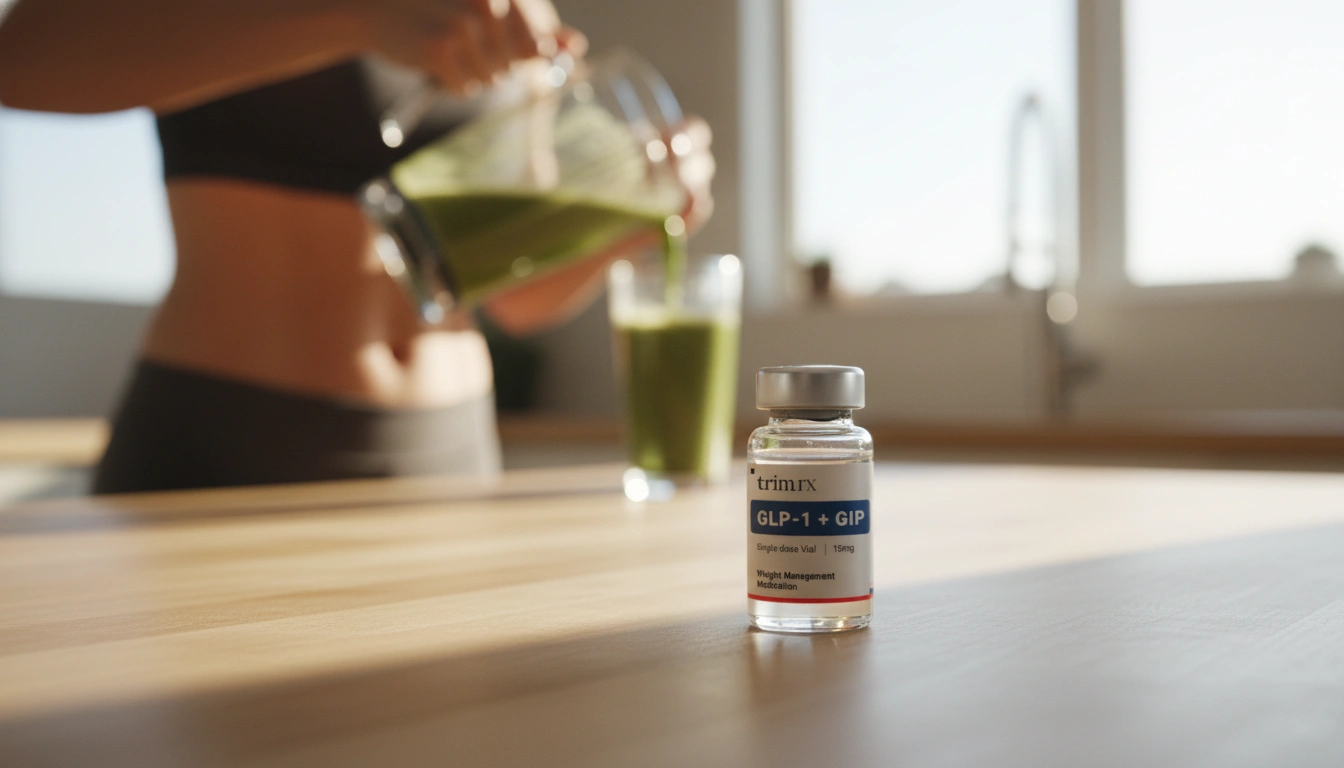What is Natural GLP-1 and How Can It Support Your Weight Loss Journey?

Introduction
What if we told you that a natural hormone in your body is crucial for managing your appetite and regulating blood sugar levels? That hormone is GLP-1. Produced in the gut, GLP-1 plays a vital role in signaling to your brain when you are full, helping to regulate food intake and maintain a healthy metabolism. Despite its significant role, many individuals are unaware of GLP-1 and its potential benefits.
The buzz around GLP-1 has intensified in recent years due to the rise of prescription medications that mimic its effects, such as semaglutide and tirzepatide. These medications have shown promise in aiding weight loss and managing type 2 diabetes, leading to an increased interest in understanding GLP-1’s natural function and how to enhance its production through lifestyle choices.
In this post, we will explore the following key topics:
- The Science Behind GLP-1: Understanding its function and importance in the body.
- Natural Sources of GLP-1: Exploring how the body produces GLP-1 in response to food intake.
- Dietary Strategies to Enhance GLP-1 Production: Identifying foods and habits that may naturally boost GLP-1 levels.
- The Role of Exercise in GLP-1 Regulation: Discussing how physical activity can impact GLP-1 secretion.
- Common Myths and Misunderstandings: Clarifying misconceptions surrounding GLP-1 and weight loss.
By the end of this blog, you will not only know what GLP-1 is but also how to leverage this knowledge for your health and wellness journey. Let’s get started!
It’s no secret that weight management is a significant concern for many. With a staggering percentage of adults in the United States classified as overweight or obese, it’s crucial to understand the biological processes that contribute to weight regulation. One such process involves a hormone that has gained attention in recent years: glucagon-like peptide-1, or GLP-1.
You may have heard about GLP-1 in relation to weight loss medications, but did you know that your body produces this hormone naturally? In this blog, we will delve into what natural GLP-1 is, its role in appetite regulation and metabolism, and discuss how we can potentially boost its levels through dietary choices and lifestyle changes. By the end, you will gain a comprehensive understanding of GLP-1 and how it may contribute to your weight loss journey.
The Science Behind GLP-1
GLP-1 is a hormone that belongs to a class of hormones known as incretins. It is primarily secreted by the L-cells in the intestine following food intake. Here’s how it works:
- Insulin Secretion: GLP-1 stimulates the pancreas to release insulin, a hormone that helps lower blood sugar levels by facilitating the uptake of glucose by the body’s cells.
- Inhibition of Glucagon: It also suppresses the release of glucagon, a hormone that raises blood sugar levels, thereby contributing to overall blood sugar regulation.
- Slowing Gastric Emptying: By slowing down the rate at which food exits the stomach, GLP-1 helps prolong feelings of fullness, which can assist in appetite control.
- Appetite Regulation: One of the most impactful roles of GLP-1 is its ability to signal to the brain that you are full, helping reduce overall food intake.
Research shows that individuals with obesity may experience a reduced response to GLP-1, which may contribute to overeating and weight gain. For those struggling with weight management, understanding how to enhance natural GLP-1 production can be an effective strategy.
Natural Sources of GLP-1
As we mentioned earlier, GLP-1 is produced naturally in the body, particularly in response to food intake. However, not all foods trigger its release equally. Certain food types have been shown to enhance GLP-1 secretion:
- Fiber-Rich Foods: Foods high in dietary fiber, such as fruits, vegetables, whole grains, and legumes, can stimulate the release of GLP-1. Fiber slows down digestion and promotes a gradual release of glucose into the bloodstream.
- Proteins: High-protein foods, including eggs, lean meats, and dairy products, can also boost GLP-1 levels. For instance, studies have indicated that protein-rich meals can elicit a more significant GLP-1 response compared to carbohydrate-rich meals.
- Healthy Fats: Sources of healthy fats, such as avocados, nuts, and olive oil, have been linked to increased GLP-1 levels. These fats not only promote satiety but also positively influence metabolic health.
- Fermented Foods: Probiotics found in fermented foods like yogurt and kefir may play a role in gut health and have been associated with increased GLP-1 production due to their positive effects on gut microbiota.
Understanding how these foods contribute to GLP-1 production helps us make informed dietary choices that can support weight management and overall health.
Dietary Strategies to Enhance GLP-1 Production
Now that we know which foods can naturally boost GLP-1 levels, let’s explore some practical dietary strategies to incorporate these foods into our daily diet:
1. Include More Fiber in Your Meals
Aim to fill half your plate with fiber-rich foods. This can be achieved by incorporating whole grains like oats, quinoa, and brown rice, as well as a variety of fruits and vegetables. For example, adding a side of steamed broccoli or a salad topped with chickpeas can increase fiber intake significantly.
2. Focus on Lean Proteins
Incorporate lean sources of protein into your meals. Eggs, chicken, turkey, fish, and plant-based proteins like beans and lentils can help stimulate GLP-1 production. A breakfast of scrambled eggs with spinach and whole-grain toast is a great way to start the day.
3. Add Healthy Fats
Incorporate sources of healthy fats into your diet. Avocado toast, a handful of nuts, or a drizzle of olive oil on your salads can help slow digestion and promote fullness, enhancing GLP-1 levels.
4. Stay Hydrated
Drink plenty of water throughout the day. Hydration is essential for overall health and can support metabolic processes, including hormone production.
5. Consider Probiotics
Integrate fermented foods into your diet to support gut health. Yogurt, kefir, kimchi, and sauerkraut can enhance the gut microbiome and potentially boost GLP-1 production.
By making these dietary changes, we can naturally promote the production of GLP-1, ultimately supporting our weight loss and health goals.
The Role of Exercise in GLP-1 Regulation
In addition to dietary choices, physical activity plays a crucial role in regulating GLP-1 levels. Regular exercise has been shown to have a positive impact on GLP-1 secretion and overall metabolic health. Here are some key points to consider:
- Aerobic Exercise: Activities such as running, swimming, or cycling can enhance GLP-1 levels. A study found that individuals who engaged in regular aerobic exercise experienced improved insulin sensitivity and increased GLP-1 response.
- Resistance Training: Strength training exercises can also contribute to GLP-1 secretion. Incorporating weight lifting or bodyweight exercises into your routine can support muscle mass and metabolic health.
- Consistency is Key: Engaging in physical activity consistently over time is vital. Aim for at least 150 minutes of moderate-intensity exercise per week, along with two days of strength training.
- Active Lifestyle: Incorporate more movement into your daily routine. Simple changes like taking the stairs, walking during your breaks, or participating in active hobbies can contribute to better GLP-1 regulation.
By combining healthy dietary habits with regular physical activity, we can create a holistic approach to boosting GLP-1 levels and improving our overall well-being.
Common Myths and Misunderstandings
As GLP-1 has gained popularity, several myths and misunderstandings have emerged. Let’s clarify some common misconceptions:
Myth 1: “You Can Get the Same Effect From Supplements”
Many products on the market claim to boost GLP-1 levels through dietary supplements. However, these claims are often misleading. While certain nutrients can support GLP-1 production, there is currently no supplement that mimics the effects of GLP-1 medications or provides the same benefits.
Myth 2: “All Foods Increase GLP-1 Equally”
Not all foods trigger GLP-1 release in the same way. Foods high in fiber, protein, and healthy fats are more effective at stimulating GLP-1 production compared to high-sugar or processed foods.
Myth 3: “Weight Loss Is Only About Caloric Deficit”
While maintaining a caloric deficit is essential for weight loss, hormones like GLP-1 also play a crucial role in regulating appetite and metabolism. Understanding the hormonal aspects of weight management can provide a more comprehensive approach to achieving and maintaining a healthy weight.
Conclusion
In summary, GLP-1 is a natural hormone that plays a vital role in regulating appetite and blood sugar levels. By understanding its function and exploring natural ways to enhance its production through dietary choices and physical activity, we empower ourselves to take control of our weight loss journeys.
At TrimRx, we believe in the power of personalized health management. Our approach combines innovative telehealth solutions with effective weight loss strategies, ensuring that you receive the support you need on your path to wellness.
If you’re interested in exploring weight loss medications like semaglutide or tirzepatide, we invite you to take our free assessment quiz to see if you qualify for our personalized weight loss program. Take the free assessment quiz here.
Additionally, consider complementing your weight loss journey with our quick-access supplements like GLP-1 Daily Support and Weight Loss Boost to support your overall wellness.
FAQ
What is GLP-1?
GLP-1, or glucagon-like peptide-1, is a hormone produced in the gut that helps regulate appetite and blood sugar levels. It promotes insulin secretion and slows gastric emptying, leading to feelings of fullness.
How can I naturally boost my GLP-1 levels?
You can enhance GLP-1 production by incorporating fiber-rich foods, lean proteins, healthy fats, and fermented foods into your diet, as well as engaging in regular physical activity.
Are there any supplements that can replace GLP-1 medications?
While some supplements claim to boost GLP-1 levels, there is currently no evidence to suggest that they can replicate the effects of GLP-1 medications. It’s essential to consult with a healthcare provider before starting any supplements.
Can exercise improve GLP-1 levels?
Yes, regular physical activity, including both aerobic and resistance training, has been shown to positively impact GLP-1 secretion and improve metabolic health.
Is GLP-1 important for weight management?
Absolutely! GLP-1 plays a crucial role in appetite regulation and blood sugar control, making it a significant factor in weight management and overall metabolic health.
By understanding and utilizing the science behind GLP-1, we can make informed choices that support our health and wellness. Embrace the journey, and remember, we’re here to support you every step of the way!

Transforming Lives, One Step at a Time
Keep reading
7 Tips for Sticking to GLP-1 Injection Schedules
Seven practical strategies to keep weekly GLP‑1 injections on schedule—pick a routine day, set reminders, manage side effects, rotate sites, and avoid missed doses.
Custom GLP-1 Dosing for Kidney Disease
Personalized GLP-1 dosing for CKD patients with monitoring, dehydration and hypoglycemia risk mitigation, and guidance across all kidney disease stages.
Semaglutide vs Tirzepatide: Approved Uses
Two leading diabetes and weight-loss drugs differ in FDA-approved benefits — one adds heart, kidney and liver protection; the other treats obstructive sleep apnea.



